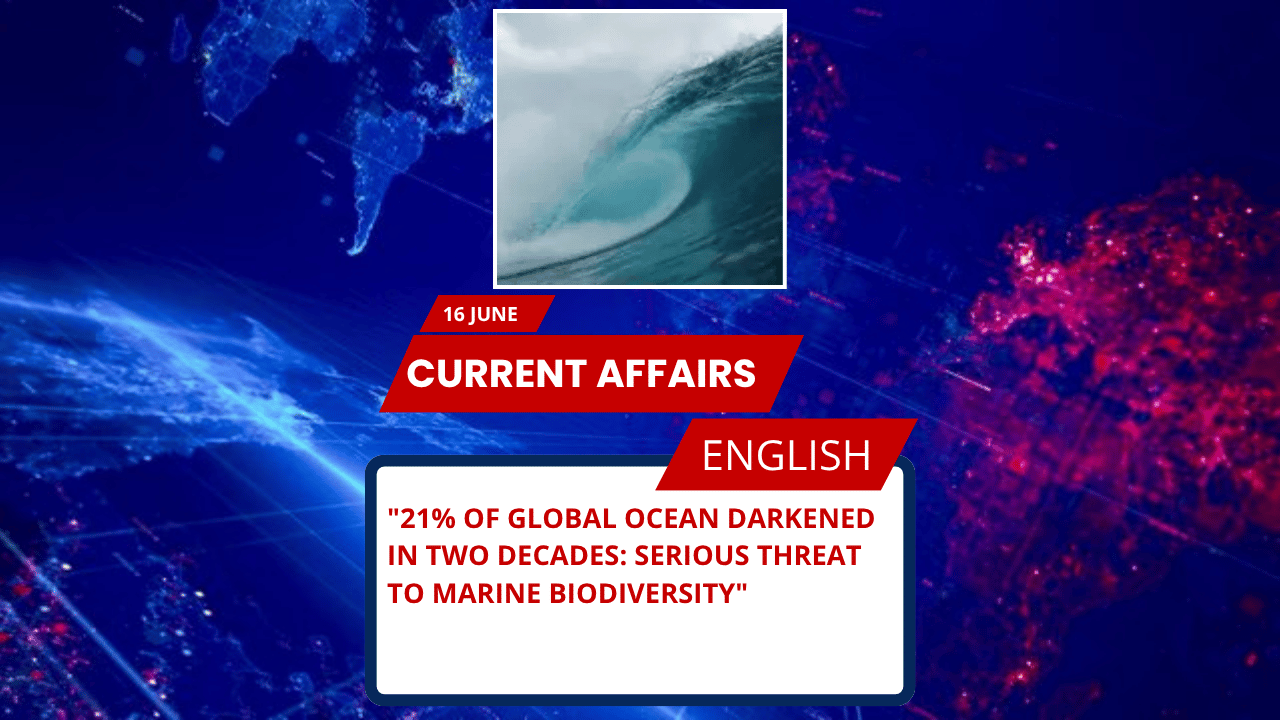
Key Points for SSC, UPSC and Other Government Exams
- 21% of the global ocean has darkened between 2003-2022, reducing light in photic zones.
- Photic zone depth declined by over 50 meters in 9% of global ocean areas.
- Ocean darkening affects photosynthesis, threatening marine ecosystems and biodiversity.
- Coastal darkening linked to agricultural runoff, sediment erosion, and algal blooms.
- Open ocean darkening caused by plankton dynamics and sea temperature rise.
- Key indicator species: Calanus copepods—essential in marine food chains.
- Ocean darkening disrupts carbon cycling, oxygen production, and climate regulation.
Detailed Explanation of Ocean Darkening
What is Ocean Darkening?
Ocean darkening refers to the reduction in the penetration of sunlight into ocean waters, especially in the photic zones (upper ~200 meters) where photosynthesis takes place. This zone is crucial for supporting marine biodiversity and maintaining ecological balance.
Research Highlights
- The study used satellite data (2003-2022) and models measuring light absorption with the diffuse attenuation coefficient (Kd 490).
- 21% of the global ocean darkened, and 9% of ocean areas saw a photic zone depth loss of over 50 meters.
- The North Sea and Arctic recorded the most significant losses in light penetration.
- Some regions, like parts of the English Channel, showed increased light levels due to local environmental factors.
Causes of Ocean Darkening
- Coastal areas: Agricultural runoff, sediment erosion → Algal blooms → Reduced sunlight penetration.
- Open ocean: Changes in plankton populations, warming sea temperatures → Altered light dynamics.
Impact on Marine Ecosystems
- Shrinking photic zones reduce habitat space for light-dependent organisms.
- Species that rely on light cues for feeding and reproduction are forced into shallower waters → Increased competition, disrupted food webs.
- Key species like Calanus copepods (critical zooplankton) are affected → Ripple effects on marine predators and overall biodiversity.
- Ocean darkening undermines carbon cycling, oxygen production, and the ocean’s climate regulation role.
Important Facts About Regions Mentioned
The Arctic
- Region: Northernmost part of Earth.
- Major water bodies: Arctic Ocean.
- Significance: Critical for global climate regulation, sensitive to temperature changes.
North Sea
- Location: Bordered by UK, Norway, Denmark, Germany, Netherlands, Belgium, France.
- Economic importance: Major shipping routes, fisheries, oil and gas reserves.
English Channel
- Location: Between southern England and northern France.
- Significance: Key maritime route, biologically diverse.
Exam-Style MCQs
1. What percentage of the global ocean has darkened between 2003 and 2022, as per recent studies?
A) 9%
B) 15%
C) 21%
D) 30%
Answer: C) 21%
2. Which species was used as an indicator for the impact of ocean darkening on marine food chains?
A) Calanus copepods
B) Blue whales
C) Coral polyps
D) Krill
Answer: A) Calanus copepods
3. In coastal areas, ocean darkening is primarily caused by:
A) Increased salinity
B) Agricultural runoff and sediment erosion
C) Volcanic eruptions
D) Oil spills
Answer: B) Agricultural runoff and sediment erosion
4. The photic zone typically extends up to a depth of:
A) 50 meters
B) 100 meters
C) 200 meters
D) 500 meters
Answer: C) 200 meters
UPSC-style FAQs (Answer Format as per UPSC Mains Guidelines)
Q1. Discuss the phenomenon of ocean darkening and its implications for marine biodiversity.
Answer:
Ocean darkening refers to the reduction in light penetration in the upper layers of the ocean, particularly the photic zone, which supports photosynthetic life. Recent studies indicate that 21% of the global ocean has darkened between 2003 and 2022, with 9% experiencing a photic zone depth loss exceeding 50 meters. The primary causes include agricultural runoff, sediment erosion, algal blooms in coastal areas, and altered plankton dynamics coupled with rising sea temperatures in open oceans.
This phenomenon threatens marine biodiversity by shrinking habitats, disrupting food webs, and affecting key processes like carbon cycling and oxygen production. Species dependent on light cues, such as Calanus copepods, face increased competition and predation, which may lead to biodiversity loss and ecological imbalance. The darkening of oceans, therefore, represents a significant environmental concern with broader implications for climate regulation and human wellbeing.
Q2. Highlight the role of the ocean in climate regulation and explain how ocean darkening can affect this role.
Answer:
The ocean plays a pivotal role in regulating Earth’s climate by acting as a major carbon sink, absorbing carbon dioxide from the atmosphere, and producing oxygen through marine photosynthesis. Phytoplankton in the photic zone are central to these processes.
Ocean darkening reduces the depth and productivity of photic zones, thereby hampering photosynthesis. This leads to lower carbon dioxide absorption and diminished oxygen production, ultimately weakening the ocean’s climate regulation capacity. The contraction of light-rich habitats also disrupts marine ecosystems, further destabilizing the balance of atmospheric gases and climate systems.
Q3. Examine the regional patterns of ocean darkening and the environmental factors contributing to these variations.
Answer:
Ocean darkening exhibits mixed regional patterns. The North Sea and Arctic have shown the greatest losses in light penetration, largely due to increased sediment inputs, ice melt, and changing ocean circulation. Conversely, areas like parts of the English Channel have experienced slight increases in light levels, influenced by localized factors such as rainfall patterns, land use changes, and water clarity improvements.
Environmental contributors include agricultural runoff, sediment erosion, algal blooms near coasts, and shifts in plankton populations and sea surface temperatures in open oceans. These factors vary across regions based on human activity and climatic conditions.







